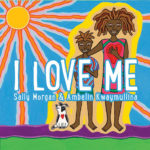Reflections on representation, illustration and diversity from an Indigenous perspective

Author and illustrator Ambelin Kwaymullina reflects on the making of I Love Me and why the representation of Indigenous peoples in picture book illustration matters.
A few months ago I showed the finished illustrations for this book to my brother, and he asked, ‘Is that you and me, when we were little?’ And I realised that, in a way, it was – or rather, it was us as I wished we had been able to find ourselves in books when we were young. There were very few books back then by Indigenous writers and illustrators. And while publishing has come a long way – largely due to the work of Indigenous publishers and of other small presses – there is still a desperate need for more Indigenous voices.

When I was painting these illustrations I thought of my family. The boy has my brother’s nose, and the girl my curly hair. The thin wrists and ankles belong to my mother and my grandmother. I thought of how proud I was to be Indigenous, and to be one of the great diversity of Indigenous writer/illustrator voices here in Australia. Then I thought of other things – like the racism I had experienced as a child from both classmates and teachers. I thought of the negative reactions I receive when I say I am Aboriginal, which includes some people taking a physical step away from me. And I thought of the barrage of distorted images of Indigenous peoples that continue to influence how we feel about ourselves and how we are perceived (and treated) by others.
Representation matters, including in picture book illustrations. Perhaps especially in illustrations, because children are fluent in the language of art in a way that most adults are not. There is no aspect of an illustration that escapes the attention of a child, and this means that to create art for children is to speak to an audience more attuned to the nuances of representation than yourself. This is one of the reasons why the misrepresentation of Indigenous peoples in illustration – or the misrepresentation of other diverse peoples, for that matter – should never be dismissed as being ‘only a picture book’.
To find yourself in story is the right of every child. To learn of the other cultures and experiences that are part of the diversity of the human species is the right of every child, too. As former UK Children’s Laureate Malorie Blackman once put it, reading is an exercise in empathy. We need more Indigenous voices and more voices of other diverse peoples speaking to our own hopes, dreams and realities. It is these connections through story that will lay the basis for other connections and so change the world.
 Ambelin Kwaymullina is from the Palyku people of the Pilbara region of Western Australia. She is the illustrator of I Love Me by Sally Morgan. More information about the book and free teaching notes are available online. Class sets of the I Love Me bookmark and teaching activity can be ordered from admin@fremantlepress.com.au.
Ambelin Kwaymullina is from the Palyku people of the Pilbara region of Western Australia. She is the illustrator of I Love Me by Sally Morgan. More information about the book and free teaching notes are available online. Class sets of the I Love Me bookmark and teaching activity can be ordered from admin@fremantlepress.com.au.



